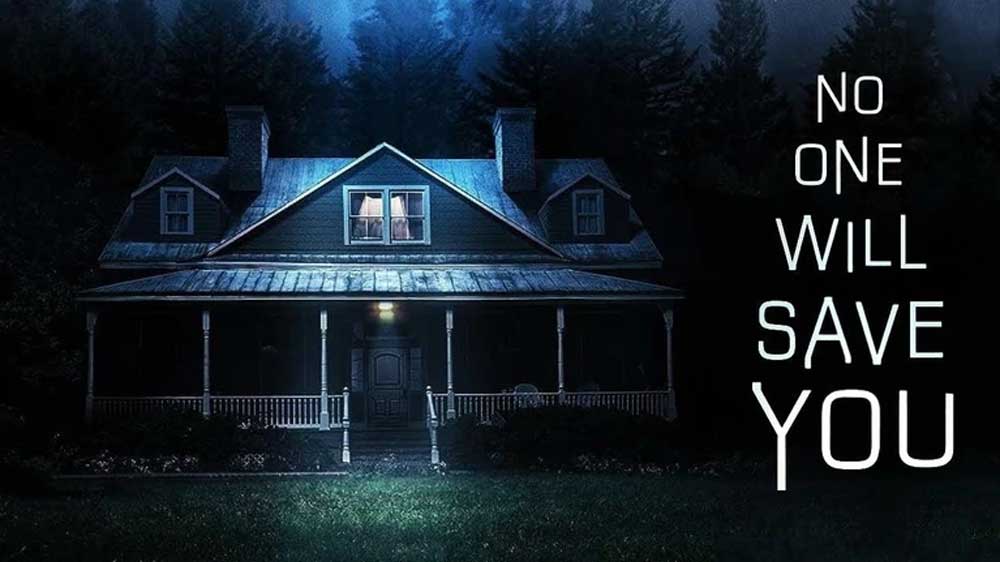No One Will Save You is the sophomore film effort by director Brian Duffield. The sci-fi horror film follows a socially isolated woman, Brynn (Kaitlyn Dever), who must fight off an alien invasion under the cover of darkness. The film uses Greys, the infamous humanoid, gray-skinned aliens with lanky proportions and black emotionless eyes. The film explores themes of grief, trauma, and isolation. The film is also notable for having only five words of spoken dialogue throughout its entire run, instead relying on atmosphere and Dever’s fantastic acting to produce horror.
While Brynn is able to kill several individual aliens, she eventually succumbs to the overwhelming numbers and superior technology of the aliens. She experiences a classic abduction scenario, caught in a tractor beam and subjected to a psychic probing of her memories. Strangely, for reasons left unexplained, she is returned to the real world without any alteration to her memories, the implantation of a parasite, or replacement as a doppelganger, unlike the presumed fate of the rest of the town.
This ambiguous ending left many viewers puzzled. What did it all mean?
Director’s Intention
In an interview with the Hollywood Reporter, Director Duffield shed light on the aliens’ perspective, emphasizing that they “recognized Brynn as a formidable opponent who doesn’t necessarily have to be an adversary.” While Duffield didn’t aim to humanize the aliens, he believed that Brynn and the extraterrestrial beings shared things in common. Brynn’s social isolation from the town led her to create her own world, symbolized by the intricate model town she constructed in her living room.
This symbolic representation extended beyond Brynn’s home, thanks to production designer Ramsey Avery. The birdhouse village motif, inspired by Brynn’s creation, permeated throughout the town. Duffield draws a parallel between Brynn’s inclination for world-building, both in the literal sense with her model villages and in the figurative sense as she dreamed of a better world where she wasn’t an outcast. This parallels with the aliens’ desire to reshape our world. In the end, the aliens, recognizing Brynn’s alignment with their goals and her remorse for past actions, extend an invitation for her to join their new world, highlighting the unexpected connection between the isolated human and the extraterrestrial invaders.
Duffield’s explanation is the stuff that film criticism and storytelling analysis is built on. However, it also comes from a blind spot all writers necessarily share. Writers often have themes, motifs, and symbolism, whether consciously or unconsciously, in mind as they build their story. Ultimately, this leads to writers obfuscating their messages to allow analysis from viewers. For instance, Duffield spoke of not wanting to “literally do a close-up of the aliens with tears in their eyes,” to get across the message that they felt Brynn’s remorse was moving and genuine. However, without this obvious visual clue, the reasons that they let Brynn go become ambiguous. In this intentional hiddenness, ideas become more open to interpretation and therein lies the tension between the director’s intention and the viewer’s interpretation.
Viewer Interpretation
For instance, the film could be interpreted as a nod to standing as an individual against a formidable system wielding near-absolute power. The aliens boast overwhelming numbers, superpowers, advanced technology, and eventually, complete control over human resources. They have systematically replaced potential dissenters with clones or infiltrated them with mind-controlling parasites, forcibly administering these parasites down their victims’ throats. They literally are shoving their ideology down people’s throats. This symbolism mirrors how institutions and systems impose social constructs, such as predatory capitalism, onto society. The film’s scarcity of dialogue parallels the feeling of lacking a voice in society, resonating particularly with marginalized groups often drowned out by powerful institutions and systems.
Brynn valiantly combats the Greys attempting to subdue her, but ultimately succumbs to their sheer power and abundant resources. The underlying message is clear: a lone human cannot thwart an alien invasion, dispelling the notion of solitary superheroes resolving global issues. Likewise, social reform necessitates collective action against forces vested in maintaining the status quo. Minor rebellions are easily suppressed and disparaged compared to widespread calls for societal change.
The end of the film finds Brynn back in her small town, coexisting with clones and infected humans. Despite the ominous presence of alien saucers in the sky, the residents appear content, oblivious to the impending threat. This scenario mirrors the observation of social injustices while being surrounded by individuals tacitly supporting the status quo. Brynn’s contentment in this replicated world reflects the adage that ignorance is bliss. Many people advocate for the status quo to evade the psychic discomfort akin to being a ‘Brynn’ within the ‘Matrix.’ The title lends itself well to this interpretation.
While this interpretation may not align precisely with Duffield’s intentions, the film’s ambiguous ending allows for diverse interpretations — a double-edged sword that garners both acclaim and criticism for its openness to myriad perspectives.
Bonus: Here is “Alien Superstar” by Beyoncé because it fits and its her internet anyway.

Comments